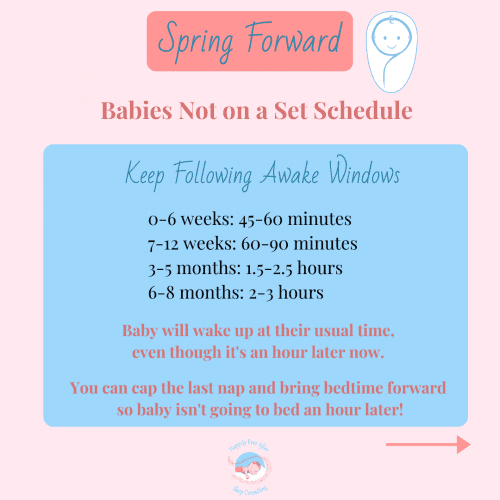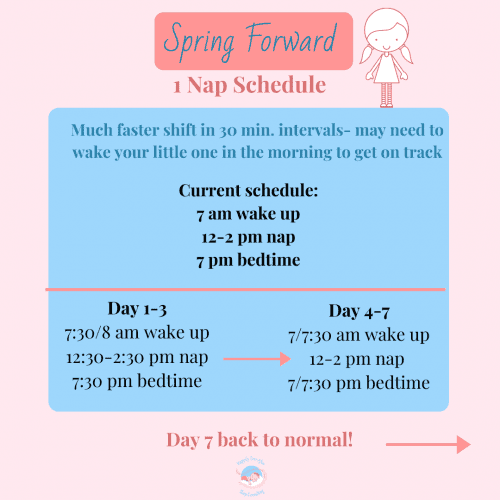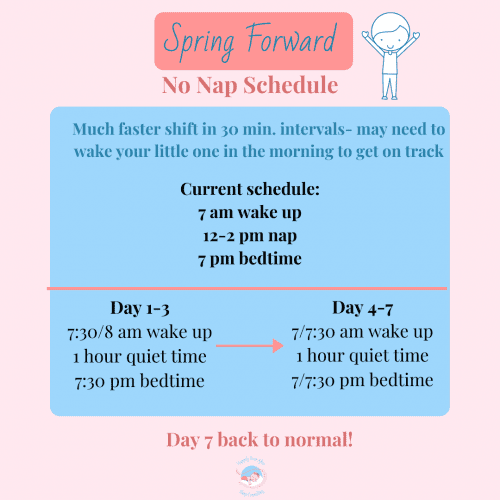Time to "Spring Forward"
February was here and gone! I am so ready for the warmer weather and extra sunshine that comes with Spring! Even if that means we lose an hour of sleep when we “Spring Forward”! Daylight savings time begins Sunday March 10th, which is less than a week away!
Should you be concerned about this change? Only if you have kids! As adults even though we may not like losing an hour of sleep, we can adjust a lot easier than our children.
Unlike during “Fall Back” you shouldn’t be dealing with an early morning wake up since we’re losing an hour of sleep. Your child will most likely sleep through the time change. In fact, if you are currently dealing with an early morning waking, this may just be the easiest solution!
But you do need to plan on making some gradual adjustments to your child’s schedule to align with the new time change. Even though it’s just an hour, it really does have an effect on all of us,– especially our little ones, who tend to be much more structured with going to bed at the same time every night and waking up at the same time every morning. I’m going to share with you how to gradually make this adjustment to your little one’s sleep schedule
Should I Start This Change Early?
If you’re thinking of getting ahead of the game and making some changes now and that would work better for you then you can absolutely start early. Since daylight savings begins Sunday, March 10th, try making the change earlier, this weekend.
You can start to modify their bedtime by 15 minutes every couple of days. For example, if your child goes to bed at 7:00 pm push it up to 6:45pm. Then, after 3 days push it up another 15 minutes, (6:30 pm) then again, a few days later until you’re at an 6:00 pm bedtime by Sunday night. This is just in time for daylight savings, because an 6:00 pm bedtime will really be 7:00 pm now with the time change.
Nap schedules can be approached the same way by gradually pushing them forward at the same interval. Again, any type of change to your child’s schedule will take about a week so don’t stress if your child is taking some type to adjust.
“Split the Difference”
We always wait until Sunday morning and then start adjusting the clocks from there. It’s much less stressful this way. Now of course if you need your little one on a set schedule for work or school reasons then you may need to make the change sooner and faster. It will still take them time to adjust, but you can “split the difference.”
By “split the difference” I mean, splitting the hour we are losing in half. Adjust your child’s schedule by 30 minutes for a few days, then another 30 minutes until you’re back on track. Sound confusing? Keep reading for more specifics!
Young Babies Following Awake Windows
If you are strictly following awake windows for your little one, then this is a simple change. Keep following those awake windows! If your little one wakes up at 7:00 am, which is now 8:00 am, start the awake window from the new time.
Early morning wakings are the worst! So if you are struggling with this and hoping for a magic solution, then you just got your wish! If you like your normal schedule, try capping that last nap and get your little one in bed a little earlier the next few nights. If you find they’re sleeping past your ideal time then you will want to wake them in the morning (within 30 minutes of your ideal time) to keep their schedule on track.

Babies or Toddlers on 2 Naps
If your baby or toddler is on 2 naps then you want to gradually shift their schedule to get back on track following the time change. Usually after the 6-7 month mark, bedtime has become more predictable and your little one is probably going to bed around the same time each night. You want to move bedtime earlier by 15 minutes every 2 nights. For example, if bedtime is normally 7:00pm (now 8:00pm) move bedtime to 7:45pm nights 1 and 2. Nights 3 and 4, 7:30pm, and so on. On night 7, you should be back to 7:00pm.
If you’re looking to make this change faster you can make the shift in 30 minute intervals versus 15 minutes. Some babies handle more awake time better than others.
Make sure you are starting your child’s bedtime routine early enough so that they are in bed by the new time, not starting the routine at the new time. Just know that it will take about a week for your child’s body to get used to this. It takes your body clock roughly one week to adjust any kind of change in sleeping habits.
What about naps? Same approach! Put baby down 15 minutes earlier for each nap until they are back to their normal schedule which should align with bedtime. You may need to wake them up in the morning to stay on track with your ideal wake time.


Toddlers on 1 Nap
If your toddler takes 1 nap, this transition should be pretty easy for them. Most likely they will be able to make this transition faster because they can handle more awake time during the day. I recommend shifting bedtime up by 30 minutes for 2-3 days. So if normal bedtime is 7:00 pm (8:00 pm now), you would put your toddler down at 7:30 pm. Do this for 2-3 nights after the time change and then on the 4th or 5th night, put him to bed at 7:00 pm. Then after a week you are back to the normal time.
Approach naps the same way. If naptime is 12-2 pm, put your child down at 12:30 pm (which will feel like 11:30 am). Stay there for 2 or 3 days then shift back to the normal time which will align with bedtime.

Toddlers or Children with No Nap
If you have a child that does not nap and normally goes to bed at 7:00 pm (8:00 pm now), you would put your child to bed at 7:30 pm (this will feel like 6:30 pm) on Sunday night, the first night of the time change. Do this for 2-3 nights, putting him to bed 30 minutes later than normal (which will feel like 30 minutes earlier), then on the 3rd or 4th night put your child to bed at the normal time.
If your child is used to their Hatch clock lighting up (or a similar clock) you can also set the clock forward gradually to align with your strategy. Start with 30 minutes for 3 nights, then push it forward another 30 minutes to have it light up at the appropriate time.
Make sure you are offering quiet time for your child so that they are still getting some independent play time and mom or dad are getting a much needed break. I highly recommend using a clock to let them know when quiet time is up so they are staying in their room for at least 45 minutes to an hour. You may need to start with less time if this is new to them.

What Else Helps the Transition?
Exposure to sunlight is a great way to help set your child’s body clock. Vitamin D is a great way to boost your child’s melatonin levels naturally which helps them fall asleep faster at bedtime. You also want to make sure you prepare for the extra hour of sunlight in the mornings. If your child’s room does not have black out blinds, I recommend you get some to help keep your child’s room dark for bedtime. This one is affordable and portable, perfect for when you travel.
Now, if you’re reading this and thinking, this all makes sense, but my child is struggling with sleep outside of the time change, I can help you! I offer customized sleep solutions to help you get your child sleeping independently for bedtime and naps. Schedule a FREE 15 minute evaluation call with me today so we can talk about some solutions for you and your family.

